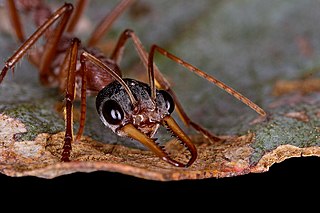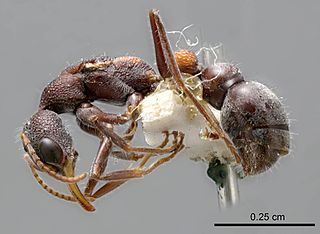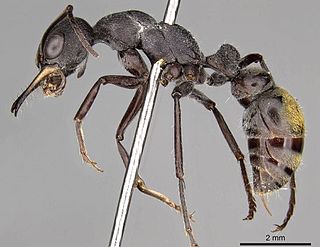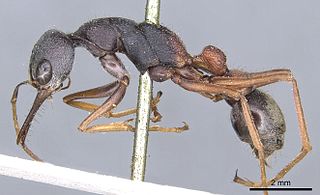
Myrmecia is a genus of ants first established by Danish zoologist Johan Christian Fabricius in 1804. The genus is a member of the subfamily Myrmeciinae of the family Formicidae. Myrmecia is a large genus of ants, comprising at least 93 species that are found throughout Australia and its coastal islands, while a single species is only known from New Caledonia. One species has been introduced out of its natural distribution and was found in New Zealand in 1940, but the ant was last seen in 1981. These ants are commonly known as bull ants, bulldog ants or jack jumper ants, and are also associated with many other common names. They are characterized by their extreme aggressiveness, ferocity, and painful stings. Some species are known for the jumping behavior they exhibit when agitated.

Myrmeciinae is a subfamily of the Formicidae, ants once found worldwide but now restricted to Australia and New Caledonia. This subfamily is one of several ant subfamilies which possess gamergates, female worker ants which are able to mate and reproduce, thus sustaining the colony after the loss of the queen. The Myrmeciinae subfamily was formerly composed of only one genus, Myrmecia, but the subfamily was redescribed by Ward & Brady in 2003 to include two tribes and four genera. An additional three genera, one form genus, and 9 species were described in 2006 from the Early Eocene of Denmark, Canada, and Washington. Subsequently an additional fossil genus was moved from the family Rhopalosomatidae in 2018, and a new genus was described in 2021.

The jack jumper ant, also known as the jack jumper, jumping jack, hopper ant, or jumper ant, is a species of venomous ant native to Australia. Most frequently found in Tasmania and southeast mainland Australia, it is a member of the genus Myrmecia, subfamily Myrmeciinae, and was formally described and named by British entomologist Frederick Smith in 1858. This species is known for its ability to jump long distances. These ants are large; workers and males are about the same size: 12 to 14 mm for workers, and 11 to 12 mm for males. The queen measures roughly 14 to 16 mm long and is similar in appearance to workers, whereas males are identifiable by their perceptibly smaller mandibles.

Nothomyrmecia, also known as the dinosaur ant or dawn ant, is an extremely rare genus of ants consisting of a single species, Nothomyrmecia macrops. These ants live in South Australia, nesting in old-growth mallee woodland and Eucalyptus woodland. The full distribution of Nothomyrmecia has never been assessed, and it is unknown how widespread the species truly is; its potential range may be wider if it does favour old-growth mallee woodland. Possible threats to its survival include habitat destruction and climate change. Nothomyrmecia is most active when it is cold because workers encounter fewer competitors and predators such as Camponotus and Iridomyrmex, and it also increases hunting success. Thus, the increase of temperature may prevent them from foraging and very few areas would be suitable for the ant to live in. As a result, the IUCN lists the ant as Critically Endangered.

Myrmecia gulosa, the red bull ant, also known as the giant bull ant or "hoppy joe", is a species of bulldog ant from the genus Myrmecia. It is abundant throughout Eastern Australia.
Myrmecia inquilina is a species of ant endemic to Australia in the subfamily Myrmeciinae, first discovered in 1955 and described by Athol Douglas and William Brown Jr. in 1959. These ants are large, measuring 21.4 millimetres (0.84 in). During the time of its discovery, Douglas and Brown announced M. inquilina as the first social parasite among the primitive subfamilies, and today it is one of the two known Myrmecia species to have no worker caste. Two host species are known, Myrmecia nigriceps and Myrmecia vindex. Aggression between M. inquilina and its host species does not occur, and colonies may only produce M. inquilina brood months after the inquiline queens begin to lay their eggs. Queens eat the colony brood or trophic eggs, and other Myrmecia species may kill M. inquilina queens if they reject them. Due to its restricted distribution and threats to its habitat, the ant is "vulnerable" according to the IUCN Red List.

Myrmecia nigriceps, also known as the black-headed bull ant, is a species of ant endemic to Australia. A member of the genus Myrmecia in the subfamily Myrmeciinae, it was first described by Austrian entomologist Gustav Mayr in 1862. These ants are large, varying from 19 to 23 millimetres in length. However, colonies contain workers that are much smaller, usually half the size of normal workers. The queens are the largest while the males are the smallest, which can be easily identified due to their small mandibles.

Myrmecia aberrans is an Australian bull ant of the genus Myrmecia. It is mostly spotted in South Australia and the states surroundings. The species of the bull ant was first described in 1900. The average length is around 12 millimetres. M. aberrans ants are commonly known as "wide jawed bull ants".

Myrmecia infima is an Australian ant species of the genus Myrmecia. First described in 1900 by Auguste-Henri Forel, Myrmecia infima are frequently seen in the western regions of Australia.

Myrmecia pyriformis, also known as the bull ant or inch ant, is an Australian ant. Myrmecia pyriformis belongs to the genus Myrmecia. It is abundant in many major cities of Australia, but mostly spotted in the eastern states. The species is of a similar appearance to the Myrmecia forficata.

Myrmecia analis is a species of the genus Myrmecia. Myrmecia analis is usually only found in Western Australia. It was described by Mayr in 1862.

Myrmecia nigrocincta, commonly known as the jumper ant or jumping jack, is an ant of the genus Myrmecia. The species was first described by Frederick Smith in 1858. Colonies of this ant are abundant in eastern Australia. Ants of this species are known for their ability to jump up to 10 centimetres, and they also have a powerful, venomous sting. Rather than foraging on the ground, M. nigrocincta prefer to forage in trees where they are known to pollinate certain flowers.

Myrmecia fulvipes is a bull ant belonging the genus Myrmecia. Native to Australia, these bull ants are found in Tasmania, Victoria, New South Wales, and Queensland.

Myrmecia arnoldi is a bull ant of the genus Myrmecia. Like all bull ants except for one species in this genus, Myrmecia arnoldi is native to Australia.

Myrmecia dichospila is an Australian ant which belongs to the genus Myrmecia. This species is endemic to Australia and is heavily distributed in South Australia and have some presence in other several states.

Myrmecia cydista is an Australian ant which belongs to the genus Myrmecia. This species is endemic to Australia. They are typically distributed in New South Wales and Queensland, and have been seen in several other states.

Myrmecia regularis is a species of ant endemic to Australia. A member of the genus Myrmecia in the subfamily Myrmeciinae, it was first described by American entomologist Walter Cecil Crawley in 1925. These ants are medium to large in size, measuring 10 to 20 millimetres, and they are bright brownish-red in colour. Queens and workers share similar morphological features, but they can be distinguished by the noticeable size difference. Males also look similar, but collected specimens are too damaged to be examined properly.

Myrmecia tepperi is an Australian ant which belongs to the genus Myrmecia. This species is native to Australia. Their distribution is large in Western Australia, South Australia, and New South Wales.
Myrmecia maxima is an unidentifiable species of ant endemic to Australia. A member of the genus Myrmecia in the subfamily Myrmeciinae, M. maxima was first described by George Fletcher Moore in 1842. As no type specimen is available, M. maxima cannot be confidently identified, but the only description Moore had provided undoubtedly describes a large Myrmecia species, having long, sharp mandibles and a formidable sting. It is still classified as a valid species. The ant resides in the south-west regions of Western Australia. As other Myrmecia species have been identified in these regions, M. maxima is possibly a senior synonym of one of these ants. Its former name is recognised as an invalid name after it was suppressed under plenary powers in 1976.

Myrmecia varians is an Australian ant which belongs to the genus Myrmecia. This species is endemic to Australia. The Myrmecia varians is one of the most distributed ants in the country, with the species being observed in every single state and territory except for Tasmania. Myrmecia varians was first described by Mayr in 1876.


















